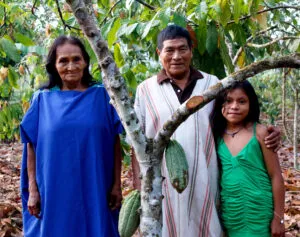Throughout the tropics, rates of forest and biodiversity loss are accelerating while the global impacts of the climate crisis are escalating. If tropical deforestation were a country, it would rank third in global emissions, behind only China and the United States. Much of this deforestation is driven by commodities such as coffee, timber, palm oil, rubber, and cocoa.
Transformative solutions are needed to ensure a forest and climate-positive future that creates long-term local benefits. Through this initiative, the Rainforest Alliance will work with the United States Agency for International Development (USAID), Clarmondial, CDP, and Conservation International to address global environmental challenges associated with commodity-driven deforestation in some of the world’s most important tropical ecosystems and sourcing regions. We will convene the private sector, governments, and local farmers and organizations in Peru, Ecuador, Brazil, and Indonesia to pilot a globally replicable landscape approach that leverages the complementary expertise of our partners while benefiting local and Indigenous communities and enterprises.

Partner communities
This initiative is expected to improve the livelihoods of more than 12,000 people, including Indigenous communities, across the four regions as well as enhance the capacity of 70 institutions—from national financial system organizations and governments to local universities and community organizations.
Key sectors for these communities include coffee, cacao, palm oil, cattle, and soy.
Objectives: enabling data-powered landscape investments
The overarching goal of this initiative is to unlock international finance for sustainable production, channel it to well-planned landscapes, and ultimately stabilize critical deforestation frontiers. To facilitate this work, we will use the newly-launched LandScale tool, a collaborative initiative co-led by the Rainforest Alliance, Verra, and Conservation International that enables the private sector, governments, and civil society to assess risk and adaptively invest in, monitor, and measure sustainability impact at the landscape level.
The initiative consists of three key components:
1. Facilitating landscape partnerships
The Rainforest Alliance and Conservation International will establish landscape level partnerships that align all of the stakeholders in an area to reduce greenhouse gas emissions, deforestation, and biodiversity threats while increasing restoration and boosting livelihoods. This will be done through the development of multi-stakeholder landscape action plans and by building the capacity of local organizations through training. Impact will be measured by landscape-level performance frameworks and tools (such as LandScale) that identify key transformation indicators.
2. Mobilizing new financing
The international investment advisory firm Clarmondial AG will lead the way in developing innovative financing mechanisms to support local landscape plans that aim to reduce deforestation, conserve biodiversity, mitigate climate change, and advance inclusive development.
3. Increasing the availability of cost-effective data
CDP, a global non-profit that runs the world’s environmental disclosure system for companies, cities, states, and regions, will work within the target areas to scale landscape and jurisdictional performance metrics and other tools. This will help unlock long-term investment, sourcing, and other incentives from companies, investors, and governments.
Desired impacts: lower emissions, protected forests, and improved livelihoods
By the end of the initiative, we aim to achieve the following outcomes:
- 12.1 million tons of CO2 emissions reduced (forecasted reductions through 2030)
- 1.8 million hectares under improved natural resource management
- Economic benefits for more than 12,000 people, leading to improved livelihoods
- US$ 30 million mobilized
These impacts will be enabled by:
- More than 300 companies and investors with enhanced engagement in landscape sourcing, investing, and strategy execution
- 70 institutions with enhanced capacity
- 27 innovative policy frameworks, standards, and tools to enable stakeholders to act
This article was previously published on the Rainforest Alliance website
Read more articles on Deforestation










